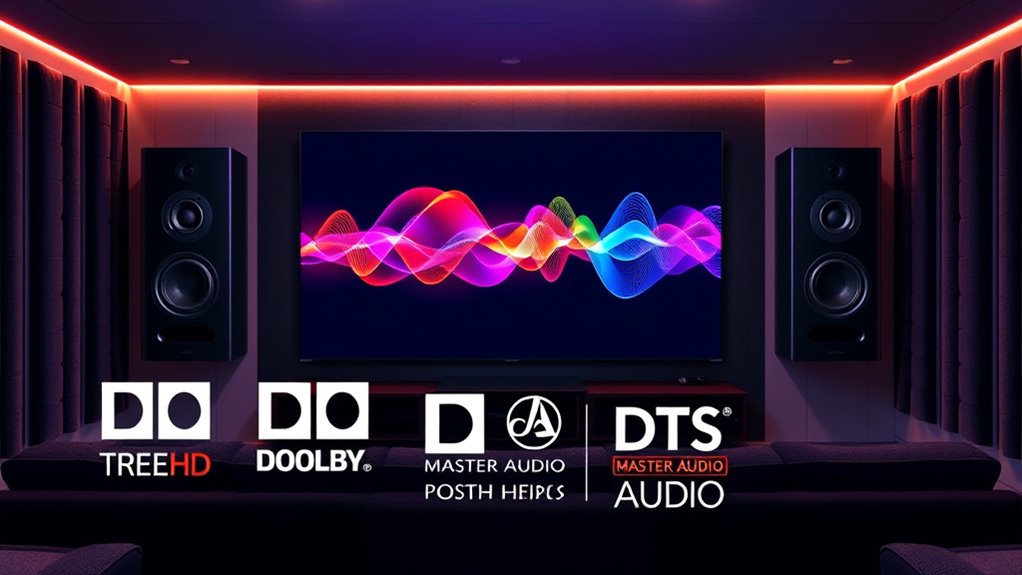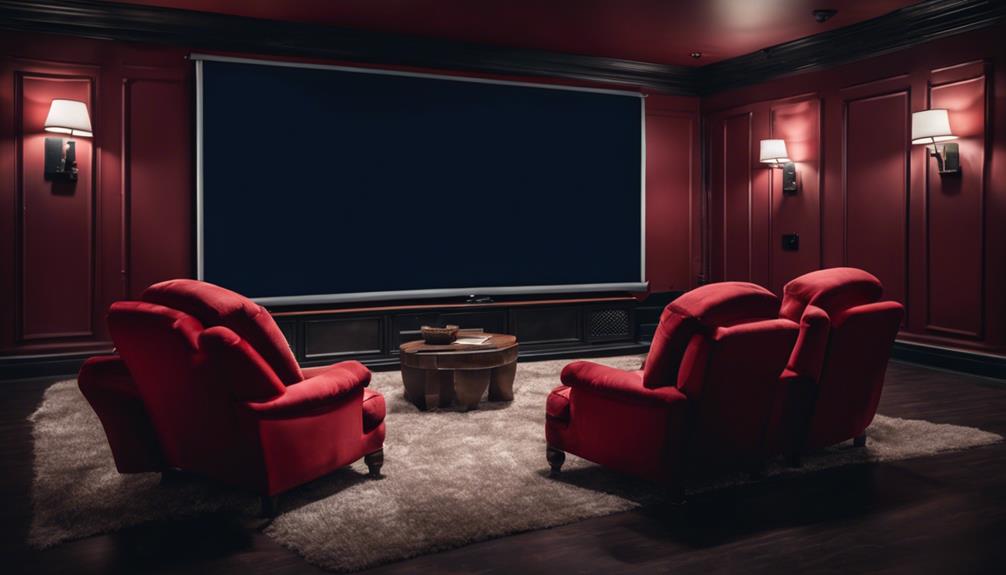If you’re comparing Dolby TrueHD and DTS-HD Master Audio, both deliver lossless, high-quality sound for your home theater, supporting up to 7.1 channels for immersive audio. Dolby TrueHD emphasizes clarity, warmth, and seamless integration with Dolby Atmos, while DTS-HD is known for a punchy, impactful sound profile. The slight differences in sound may influence your preference, depending on your system and tastes. To better understand which suits you best, there’s more to discover.
Key Takeaways
- Both Dolby TrueHD and DTS-HD Master Audio deliver lossless, high-definition sound suitable for immersive home theater experiences.
- Dolby TrueHD emphasizes clarity and warmth, often integrated with Dolby Atmos for height channels.
- DTS-HD Master Audio provides slightly higher bit rates, resulting in more detailed and impactful sound.
- Compatibility depends on your audio equipment, with both formats supporting up to 7.1 channels.
- The choice between them often hinges on personal preference and specific system support, as differences are subtle.

Have you ever wondered how movie theaters deliver such immersive audio experiences? The secret lies in the advanced surround sound formats used to encode and decode audio tracks, creating a rich, three-dimensional soundscape. Two of the most popular formats for high-definition home theater systems are Dolby TrueHD and DTS-HD Master Audio. Both deliver lossless audio quality, meaning they preserve the original sound data from the studio recordings without compression artifacts. But they have distinct characteristics that can influence your listening experience.
Discover how Dolby TrueHD and DTS-HD Master Audio deliver immersive, lossless sound for a cinematic experience at home.
Dolby TrueHD is designed to provide pristine, high-fidelity sound, often used in Blu-ray discs and professional cinema. It supports up to 7.1 channels, allowing for precise placement of sounds around you. Dolby’s encoding emphasizes clarity and warmth, making dialogue clear and effects detailed. It utilizes sophisticated compression techniques that retain the full dynamic range and subtle nuances of the original soundtrack. When you listen to Dolby TrueHD, you’re experiencing sound that’s as close to the studio master as possible, with minimal loss or distortion. Additionally, its compatibility with advanced home theater technologies ensures seamless integration with modern entertainment systems. The development of lossless audio formats has significantly improved the quality and realism of home theater sound experiences. Furthermore, understanding the surround sound formats can help you make more informed choices for your audio setup.
DTS-HD Master Audio also offers lossless quality and supports up to 7.1 channels, but it’s known for its slightly higher bit rates, which can translate into more detailed sound. DTS has a reputation for delivering punchy, impactful audio, especially for action scenes or music. Its encoding process is optimized for delivering vivid, dynamic soundscapes with a focus on impact and depth. Some audiophiles prefer DTS for its slightly more aggressive and lively sound profile, which can make movies feel more immersive and energetic.
While both formats are capable of delivering exceptional quality, your choice may depend on your equipment and preferences. Dolby TrueHD tends to be more widely supported and integrated into various home theater systems, especially those with Dolby Atmos capabilities, which add height channels for even more realism. DTS-HD Master Audio is often found in premium sound systems and is favored by those who prefer a more intense sound experience. Ultimately, the difference between the two is subtle, and high-quality playback equipment can make either format sound incredible.
In essence, both Dolby TrueHD and DTS-HD Master Audio are designed to bring cinematic audio into your home with precision and clarity. They serve the same purpose—delivering lossless, immersive sound—but do so with slight nuances that can appeal differently depending on your listening tastes and system setup.
Frequently Asked Questions
Can I Upgrade My Existing Home Theater to Support Both Formats?
You can definitely upgrade your home theater to support both Dolby TrueHD and DTS-HD Master Audio. Start by checking if your receiver and source devices are compatible with these formats. If they aren’t, consider upgrading your receiver to one that supports both. Additionally, verify your media players and cables are compatible. With the right upgrades, you’ll enjoy high-quality surround sound from both formats seamlessly.
Which Format Offers Better Compatibility With Streaming Services?
While compatibility with streaming services might seem like a minor detail, it’s actually pretty important. You’ll find that Dolby TrueHD generally has broader support across popular platforms and devices, making it easier to enjoy consistent quality without hassle. DTS-HD Master Audio, though excellent, may encounter occasional limitations with certain streaming apps. So, if seamless streaming experience matters most, Dolby TrueHD could be the more reliable choice for your home theater system.
Are There Differences in How These Formats Handle Multi-Channel Audio?
You want to know how these formats handle multi-channel audio. Dolby TrueHD and DTS-HD Master Audio both deliver high-quality, lossless sound, but they handle multi-channel audio slightly differently. Dolby TrueHD supports up to 7.1 channels, offering precise channel separation, while DTS-HD Master Audio can support even more channels, up to 7.1 or 11.1 in some cases. Your choice depends on your system’s compatibility and your preference for channel configurations.
Do I Need Special Equipment to Experience Dolby Truehd or DTS-HD Master Audio?
Perfectly pondering about playback? To experience Dolby TrueHD or DTS-HD Master Audio, you’ll need compatible equipment. These formats require a Blu-ray player, a receiver that supports high-definition audio, and an HD-capable TV or projector. Without this specialized setup, you’ll miss out on the magnificent multi-channel sound. So, guarantee your system supports these formats to fully feel the fantastic, full-bodied, and flawless surround sound experience.
How Do These Formats Impact Overall Sound Quality in Multi-Room Setups?
You’ll notice that these formats markedly enhance your multi-room setup’s sound quality by delivering richer, more detailed audio across all speakers. They support higher bit rates and advanced compression, ensuring clear dialogue and deep bass. To get the most out of them, make sure your equipment supports these formats. Proper setup and compatible hardware allow you to experience immersive, cinema-like sound throughout your entire space, making your multi-room audio more dynamic and engaging.
Conclusion
Now that you’ve glimpsed the worlds of Dolby TrueHD and DTS-HD Master Audio, think of them as twin stars guiding your home theater journey. Each offers a shimmering, immersive experience, wrapping you in a cocoon of crystal-clear sound. Whether you choose the warm embrace of Dolby or the bold roar of DTS, you’re revealing a universe of cinematic magic. So, let your surround sound system become your personal portal to a vibrant, lifelike universe right in your living room.















